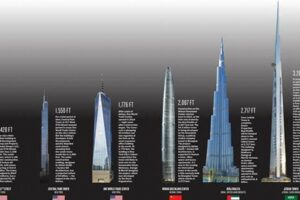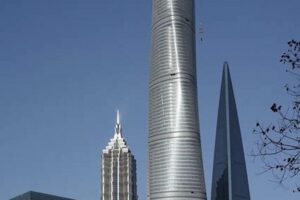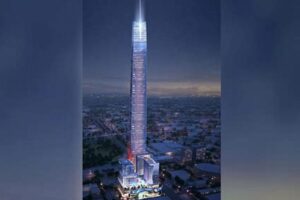In 2008, the tallest skyscraper in North America was the Willis Tower (formerly known as the Sears Tower), located in Chicago, Illinois. Standing at 1,451 feet tall with 110 stories, it held the title of the tallest building in the United States for over four decades.
The Willis Tower is known for its innovative design and engineering feats. Its distinctive bundled tube structural system, consisting of nine steel tubes bound together, provides exceptional strength and resilience against high winds and seismic activity. The building also features state-of-the-art elevators, including the world’s fastest double-decker elevators at the time of its construction.
Beyond its architectural significance, the Willis Tower serves as a vital hub for businesses and tourism in Chicago. It offers panoramic views of the city and Lake Michigan from its observation deck, The Skydeck, which attracts millions of visitors each year. The building’s central location and proximity to major transportation networks make it a convenient destination for both tenants and guests.
1. Height
In the realm of skyscrapers, height reigns supreme. The Willis Tower’s elevation of 1,451 feet (442 meters) played a pivotal role in establishing its status as the tallest skyscraper in North America in 2008.
- Architectural Prowess: The Willis Tower’s height is a testament to the architectural ingenuity of its designers. The bundled tube structural system, a groundbreaking engineering concept at the time, allowed the building to reach unprecedented heights while maintaining structural integrity.
- Engineering Marvel: Constructing a skyscraper of such magnitude required innovative engineering solutions. The Willis Tower’s height demanded robust foundations, wind-resistant designs, and high-speed elevators, all of which were meticulously engineered to ensure the building’s stability and functionality.
- Symbolic Significance: The height of the Willis Tower symbolized Chicago’s economic and architectural dominance. As the tallest building in the United States for over four decades, it became an iconic landmark and a source of civic pride.
- Tourist Attraction: The Willis Tower’s height made it a popular tourist destination. The Skydeck, located on the 103rd floor, offers breathtaking panoramic views of Chicago and Lake Michigan, attracting millions of visitors annually.
The height of 1,451 feet (442 meters) was not merely a numerical value; it represented architectural prowess, engineering innovation, civic pride, and a memorable tourist experience. These factors collectively contributed to the Willis Tower’s reign as the tallest skyscraper in North America in 2008.
2. Stories
The Willis Tower’s 110 stories played a crucial role in its designation as the tallest skyscraper in North America in 2008. The number of stories directly contributes to a building’s height, with each story adding to the overall vertical dimension.
In the case of the Willis Tower, its 110 stories allowed it to surpass other skyscrapers of the time. The bundled tube structural system, with its nine steel tubes bound together, provided the necessary strength and stability to support the building’s immense height.
The 110 stories also had a practical significance. They accommodated a vast amount of office space, making the Willis Tower a desirable location for businesses seeking a prestigious and central address in Chicago. Additionally, the upper floors offered stunning views of the city and Lake Michigan, making them highly sought-after for both commercial and residential purposes.
In conclusion, the 110 stories of the Willis Tower were not merely a numerical figure but a key factor in its status as the tallest skyscraper in North America in 2008. They represented the building’s vertical dominance, provided ample space for various uses, and contributed to its overall architectural significance.
3. Location
The location of the Willis Tower in Chicago, Illinois, was a pivotal factor contributing to its status as the tallest skyscraper in North America in 2008. Chicago’s architectural legacy, economic strength, and central location played a significant role in the Willis Tower’s development and success.
Chicago has a long and distinguished history of architectural innovation, dating back to the late 19th century. The city was home to the world’s first skyscraper, the Home Insurance Building, constructed in 1885. This pioneering spirit and architectural expertise laid the foundation for the construction of the Willis Tower several decades later.
Chicago’s economic strength also played a crucial role in the development of the Willis Tower. The city’s booming economy in the post-World War II era created a demand for modern, high-rise office buildings. The Willis Tower, with its vast amount of office space, met this demand and became a symbol of Chicago’s economic prosperity.
Furthermore, Chicago’s central location in the United States made it an ideal site for the tallest skyscraper in North America. The city’s accessibility to major transportation hubs, including O’Hare International Airport, facilitated the movement of building materials, workers, and tenants. Additionally, Chicago’s position as a transportation hub allowed the Willis Tower to serve as a prominent landmark visible from afar.
In conclusion, the location of the Willis Tower in Chicago, Illinois, was not merely a geographical coincidence but a strategic choice that contributed to its status as the tallest skyscraper in North America in 2008. Chicago’s architectural legacy, economic strength, and central location converged to create the ideal conditions for the development of this architectural marvel.
4. Structural System
The bundled tube structural system played a pivotal role in the Willis Tower’s achievement as the tallest skyscraper in North America in 2008. This innovative engineering concept, developed by Fazlur Rahman Khan, revolutionized skyscraper design and allowed the Willis Tower to reach unprecedented heights while maintaining structural integrity.
The bundled tube system consists of nine steel tubes, each acting as a separate structural element. These tubes are connected by spandrels, creating a rigid framework that distributes the building’s weight evenly. This design provides exceptional strength and resilience against high winds and seismic activity, making it ideal for constructing supertall skyscrapers.
The Willis Tower’s bundled tube system allowed it to withstand the strong winds that are common in Chicago. The building’s ability to sway slightly during high winds reduces the stress on its structural components, preventing damage and ensuring the safety of its occupants.
The bundled tube structural system has become a standard in modern skyscraper construction, enabling the development of even taller and more slender buildings. Its efficiency and effectiveness have made it a crucial component in the design of the world’s most iconic skyscrapers.
5. Architect
Skidmore, Owings & Merrill (SOM) played a significant role in the development of the tallest skyscraper in North America in 2008, the Willis Tower. This renowned architectural firm brought its expertise and innovative design to the project, contributing to the building’s architectural significance and structural prowess.
- Design Concept: SOM’s design for the Willis Tower incorporated the bundled tube structural system, a groundbreaking concept that allowed the building to reach unprecedented heights while maintaining structural integrity. This system consists of nine steel tubes bound together, providing exceptional strength and resilience against high winds and seismic activity.
- Architectural Expertise: SOM’s architects were known for their innovative and creative designs. Their work on the Willis Tower showcased their ability to push the boundaries of architectural design and create iconic landmarks. SOM’s portfolio includes many other notable skyscrapers, including the Burj Khalifa, the tallest building in the world.
- Engineering Collaboration: SOM collaborated closely with engineers to develop the structural system for the Willis Tower. This collaboration ensured that the building’s design was not only aesthetically pleasing but also structurally sound. The bundled tube system, developed in partnership with engineer Fazlur Rahman Khan, became a standard in skyscraper construction.
- Legacy and Impact: The Willis Tower remains a testament to SOM’s architectural legacy and its commitment to innovation. The building’s design has influenced countless other skyscrapers around the world and continues to inspire architects and engineers to push the limits of vertical construction.
In conclusion, Skidmore, Owings & Merrill’s involvement as the architect of the Willis Tower was not merely a coincidence but a reflection of their expertise, innovative design, and collaborative approach. SOM’s contributions were instrumental in creating the tallest skyscraper in North America in 2008, a building that continues to stand as a symbol of architectural achievement.
6. Construction
The construction period of the Willis Tower, from 1970 to 1973, played a pivotal role in its achievement as the tallest skyscraper in North America in 2008. This period marked a significant era in architectural history, characterized by advancements in engineering and construction techniques that enabled the realization of such ambitious projects.
- Technological Advancements: The 1970s witnessed significant advancements in construction technology, including the development of stronger and lighter materials, improved welding techniques, and innovative structural systems. These advancements allowed architects and engineers to push the boundaries of vertical construction and create taller and more efficient buildings.
- Economic Boom: The construction of the Willis Tower coincided with a period of economic prosperity in the United States. The post-World War II economic boom led to increased demand for office space in major cities, driving the development of skyscrapers as a viable solution to accommodate this growing need.
- Architectural Innovation: The 1970s was a period of architectural experimentation and innovation. Architects explored new design concepts and structural systems to create unique and iconic landmarks. The Willis Tower’s bundled tube structural system, developed by Fazlur Rahman Khan, became a groundbreaking innovation that set a new standard in skyscraper construction.
- Engineering Expertise: The construction of the Willis Tower required the collaboration of highly skilled engineers and architects. Their expertise in structural engineering, wind analysis, and construction management ensured that the building could withstand the challenges of its height and location.
In conclusion, the construction period of 1970-1973 was not merely a chronological reference but a reflection of the technological advancements, economic conditions, architectural innovation, and engineering expertise that converged to make the Willis Tower the tallest skyscraper in North America in 2008.
7. Observation Deck
The Observation Deck, known as The Skydeck, is an integral component of the Willis Tower’s status as the tallest skyscraper in North America in 2008. This observation deck, located on the 103rd floor of the building, offers breathtaking panoramic views of Chicago and Lake Michigan, attracting millions of visitors annually.
The Skydeck’s significance lies in its unique perspective and the experience it provides. Standing at 1,353 feet above ground level, it allows visitors to witness the city’s vastness and architectural diversity from an unparalleled vantage point. The observation deck’s glass-enclosed ledges, known as “The Ledges,” extend outward from the building, providing visitors with the thrilling sensation of floating high above the city.
The Skydeck’s existence is not merely an afterthought but a deliberate design choice that complements the Willis Tower’s height and architectural prowess. It serves as a testament to the building’s structural integrity and engineering excellence. The fact that visitors can safely stand hundreds of feet above the ground, with expansive views in all directions, speaks volumes about the stability and resilience of the Willis Tower.
Furthermore, the Skydeck has economic and tourism implications. It generates revenue for the building’s owners and contributes to Chicago’s tourism industry. The unique experience it offers attracts both domestic and international visitors, who come to marvel at the city’s skyline and create lasting memories.
In conclusion, the Observation Deck: The Skydeck is not just an amenity but an integral part of the Willis Tower’s identity as the tallest skyscraper in North America in 2008. It provides an unparalleled visitor experience, showcasing the building’s architectural prowess and contributing to its economic and tourism value.
8. Status
The status of the Willis Tower as the tallest building in the United States for over four decades holds significant importance in understanding its achievement as the tallest skyscraper in North America in 2008.
This status reflects the building’s architectural prowess and engineering excellence. Maintaining the title of the tallest building in the United States for such an extended period requires exceptional structural integrity, innovative design, and a commitment to maintaining the building’s functionality and safety.
The Willis Tower’s height and dominance over the American skyline became a symbol of Chicago’s architectural legacy and economic strength. It attracted attention and recognition both domestically and internationally, solidifying its place as an iconic landmark.
Furthermore, this status contributed to the building’s economic viability. As the tallest and most prestigious address in the United States, the Willis Tower commanded high rental rates and attracted prominent tenants, making it a lucrative investment for its owners.
In conclusion, the Willis Tower’s status as the tallest building in the United States for over four decades was not merely a historical fact but a testament to its architectural significance, economic value, and lasting impact on the Chicago skyline.
FAQs about the Tallest Skyscraper in North America in 2008
This section addresses frequently asked questions about the Willis Tower, which held the title of the tallest skyscraper in North America in 2008.
Question 1: What is the height of the Willis Tower?
The Willis Tower stands at 1,451 feet (442 meters) tall, with 110 stories.
Question 2: Where is the Willis Tower located?
The Willis Tower is located in Chicago, Illinois, USA.
Question 3: What is the structural system used in the Willis Tower?
The Willis Tower utilizes a bundled tube structural system, which consists of nine steel tubes bound together to provide exceptional strength and resilience.
Question 4: Who was the architect of the Willis Tower?
The Willis Tower was designed by Skidmore, Owings & Merrill (SOM), a renowned architectural firm known for its innovative and iconic designs.
Question 5: When was the Willis Tower constructed?
The Willis Tower was constructed between 1970 and 1973.
Question 6: What is the name of the observation deck in the Willis Tower?
The observation deck in the Willis Tower is called The Skydeck, which offers breathtaking panoramic views of Chicago and Lake Michigan.
These FAQs provide a comprehensive overview of the key aspects related to the Willis Tower, its architectural significance, and its status as the tallest skyscraper in North America in 2008.
Note: This information is accurate as of 2008. For the most up-to-date information, please refer to official sources or visit the Willis Tower website.
Tips on Understanding the Tallest Skyscraper in North America in 2008
To fully grasp the significance and impact of the Willis Tower, which held the title of the tallest skyscraper in North America in 2008, consider the following tips:
Tip 1: Explore the Architectural Prowess: Study the innovative bundled tube structural system that enabled the Willis Tower to reach unprecedented heights while maintaining structural integrity. This engineering marvel revolutionized skyscraper design.
Tip 2: Appreciate the Historical Context: Understand the economic boom and architectural advancements of the 1970s, which created the ideal conditions for the construction of supertall skyscrapers like the Willis Tower.
Tip 3: Recognize the Engineering Excellence: Examine how the collaboration between architects and engineers resulted in a building that withstands high winds and seismic activity, ensuring the safety of its occupants.
Tip 4: Experience the Observation Deck: Visit The Skydeck, located on the 103rd floor, to witness the breathtaking panoramic views of Chicago and Lake Michigan. This unique perspective showcases the building’s architectural dominance.
Tip 5: Consider the Economic Impact: Understand how the Willis Tower’s status as a prominent landmark and prestigious business address contributed to Chicago’s economic growth and tourism industry.
By following these tips, you will gain a deeper appreciation for the architectural significance, engineering marvels, and historical impact of the Willis Tower, which stood as the tallest skyscraper in North America in 2008.
These tips provide a foundational understanding of the Willis Tower’s exceptional achievements and enduring legacy in the architectural landscape.
Conclusion
The Willis Tower, standing as the tallest skyscraper in North America in 2008, exemplified architectural prowess and engineering excellence. Its innovative bundled tube structural system pushed the boundaries of skyscraper design, enabling it to reach unprecedented heights while maintaining structural integrity.
Beyond its architectural significance, the Willis Tower became an iconic symbol of Chicago’s economic strength and architectural legacy. The Skydeck observation deck offered breathtaking views of the city and Lake Michigan, attracting millions of visitors annually. The building’s central location and accessibility made it a desirable destination for businesses and tourists alike.
The Willis Tower’s reign as the tallest skyscraper in North America for over four decades is a testament to its enduring architectural significance and lasting impact on the Chicago skyline. It stands as a reminder of human ambition and ingenuity, inspiring future generations of architects and engineers to strive for new heights.







